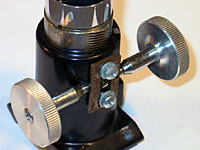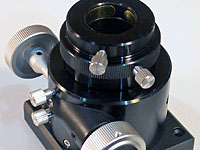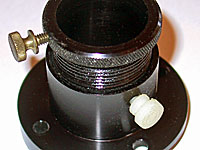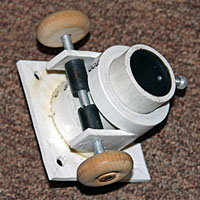

The Focuser
A focuser holds the eyepiece and allows it to be moved along the optical axis to achieve a sharp image. Eyepieces come in two sizes: 1¼ and 2 inch diameters, and the focuser needs to one or both of these sizes. 2 inch eyepieces are generally those that have both low power and a wide field of view, and are typically very expensive. If this is your first telescope, you probably will not own a two inch eyepiece for a while, if ever.
2 inch focusers usually come with a 1¼ inch adapter so both sizes of eyepieces can be used. As we have seen previously, the wider opening at the base of a 2 inch focuser can help prevent vignetting by providing a larger opening for the 'light cone' coming out of the tube to the focuser. This is the primary reason a 2 inch focuser would be installed on a first telescope, and it does give you the added flexibility to use a larger diameter eyepiece should you obtain one in the future.
Type of Focusers

Rack & Pinion: For many years the standard focuser was of the rack-and-pinion type - a small pinion gear moved the flat toothed rack that was attached to or built into the moving focusing tube that holds the eyepiece. However, this geared system was far from ideal, with some wobble due to the friction fit between the fixed and moving tubes and backlash due to the gears. As eyepieces got larger and heavier, these problems became greater. Many rack-and-pinion focusers also had an extra hole to mount a single vane stalk that projected down into the tube to hold the diagonal mirror. Diagonal tip and tilt were usually adjusted by bending the stalk. You can find a basic and very serviceable rack & pinion focuser for $30 to $40 in 2010, although unlike the classic example in the photo, expect plenty of plastic to be used in the construction.

Crayford: Today, the Crayford style focuser has taken over as the standard, which uses the friction of a toothless round shaft pressed against a machined flat in the drawtube to provide smooth, backlash free movement. The draw tube rides on 4 bearings (usually ball bearing, but sometimes Teflon pads) on the side opposite the shaft. This five point suspension system can eliminate any wobble as the tube moves. It truly is a superior design, which accounts for its popularity. Like it's rack & pinion older sibling, the Crayford is available in both 1¼ and 2 inch sizes, although the 2 inch size dominates the market. We can't ever recall seeing a stalk holder on a Crayford. High end Crayfords can cost $200 or more, while moderate priced models generally come in just under $100 (which is about what the one we bought cost).


Find plans for this at the ATMsite (mirror).
Helical: There are many other styles, but we will only mention two more: helical focusers and friction-fit focusers. In helical focusers, the drawtube has a helical thread on it and you screw the drawtube in and out to achieve focus. They are excellent at making fine focus adjustments, but large focus movements are tedious and slow. For this reason, they are much less popular then other types. Some helical models have a friction fit draw tube for quick gross focusing; then you use the helical part for fine focusing. You can find 2" basic helical focusers for $40 and up in 2010.
Fiction Fit: The ultimate in simplicity, a fiction fit focuser uses a fixed tube in which the eyepiece is slide in and out of to achieve focus. It's major downfall is that fine focus adjustments can be difficult, and focus range can be limited (using an inexpensive extension tube can solve the later problem). The 'plumbing parts' focuser we present next is a friction-fit design. A home made plumbing parts focuser is well under $5 in material and can be quickly and easily built. See photos on next page.
Make or Buy?
If you want to make everything on the scope, or if you are on a tight budget, you can certainly build a simple and serviceable friction fit focuser. If you have more than basic woodworking skills, or can do some metal work, you can find plans for more advanced home built focusers elsewhere on the web. Most people who build telescopes purchase a focuser, because building a really good one requires skills and tools that most people do not have. While we will show you how to make a basic focuser, we will install a 2" mid-priced Crayford focuser on our telescope, one of the two purchased parts we will use (the other is the diagonal mirror).
Remember, no part of a home built telescope should be considered permanent - upgrades and tinkering are always done. So whatever focuser you start with, you can update it later if you are not satisfied with it.
Previous: Installing a Primary Mirror in a Cell Next:
Build a Plumbing Part Focuser
Back to the Build a Dobsonian Master Index